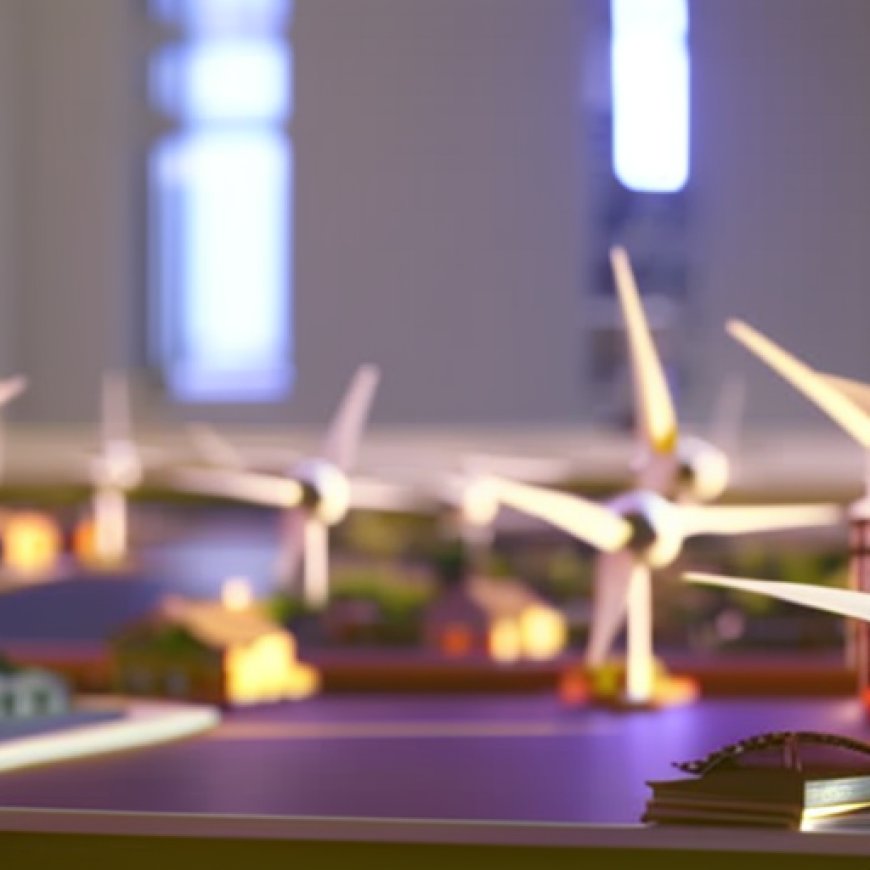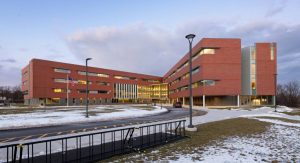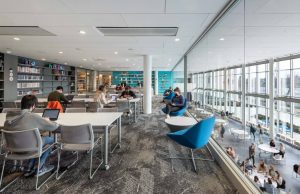Massachusetts school models sustainability with alternative energy sources
Massachusetts school models sustainability with alternative energy ... The Construction Specifier


Skanska Completes Construction and Renovation of Belmont Middle and High School

Skanska finished the $256 million construction and renovation of Belmont Middle and High School in Belmont, Massachusetts.
Photos courtesy Skanska.
Skanska has completed the construction and renovation of Belmont Middle and High School, a project that cost $256 million. The project, spanning 41,899 square meters (451,000 square feet), prioritized sustainability by utilizing alternative energy sources such as geothermal wells and solar energy.
Sustainable Development Goals (SDGs)
- Goal 7: Affordable and Clean Energy – The new school is 100 percent fossil fuel-free, relying on a geothermal system with 283 geothermal wells for heating and cooling. This commitment to renewable energy aligns with the town of Belmont’s goal to reduce its carbon footprint.
- Goal 7: Affordable and Clean Energy – The school features an array of solar panels on its roof, contributing to one-third of the property’s energy needs. This reliance on renewable energy reduces the school’s dependence on non-renewable power.
- Goal 13: Climate Action – The project is currently seeking Leadership in Energy and Environmental Design (LEED) gold certification, demonstrating its commitment to sustainable building practices.
- Goal 9: Industry, Innovation, and Infrastructure – Modern technology tools, such as StructionSite for project documentation and progress tracking, laser scanning for facade work, and drones for photo and video content capture, were used to enhance operational efficiency during construction.
The project involved extensive construction and renovation work, replacing the old high school with a new facility that houses grades seven through 12.
CHA Consulting operated as the owner’s project manager, and Perkins & Will served as the architects for this project.
The project included the construction of a new four-floor structure with academic and science wings, media facilities, administrative and health suites, and a new dining area. Additionally, renovations were made to the gymnasium and swimming pool, and new playing fields, landscaping, access points, drop-off circles, and sidewalks were added.

“We’re thrilled to be celebrating the completion of the transformative reconstruction of Belmont Middle and High School,” says Bryan Northrop, executive vice-president for Skanska USA Building’s New England region. “Working in tandem with the Town of Belmont to ensure all goals were met, we utilized our extensive experience in building educational facilities to successfully execute this substantial renovation on time and with minor disruption to the students’ and faculty’s day-to-day operations. The fossil fuel-free facility will meet LEED gold standards and sets the benchmark for sustainable school construction in Massachusetts.”
SDGs, Targets, and Indicators
-
SDG 7: Affordable and Clean Energy
- Target 7.2: Increase substantially the share of renewable energy in the global energy mix.
- Indicator: Utilization of geothermal wells and solar panels for energy generation in the school.
-
SDG 13: Climate Action
- Target 13.2: Integrate climate change measures into national policies, strategies, and planning.
- Indicator: Construction of a fossil fuel-free facility and reduction of carbon footprint.
-
SDG 9: Industry, Innovation, and Infrastructure
- Target 9.4: Upgrade infrastructure and retrofit industries to make them sustainable.
- Indicator: Use of modern technology tools for project documentation, progress tracking, and operational efficiency.
-
SDG 11: Sustainable Cities and Communities
- Target 11.6: Reduce the adverse per capita environmental impact of cities.
- Indicator: LEED gold certification for the project, indicating sustainable construction practices.
Table: SDGs, Targets, and Indicators
| SDGs | Targets | Indicators |
|---|---|---|
| SDG 7: Affordable and Clean Energy | Target 7.2: Increase substantially the share of renewable energy in the global energy mix. | Utilization of geothermal wells and solar panels for energy generation in the school. |
| SDG 13: Climate Action | Target 13.2: Integrate climate change measures into national policies, strategies, and planning. | Construction of a fossil fuel-free facility and reduction of carbon footprint. |
| SDG 9: Industry, Innovation, and Infrastructure | Target 9.4: Upgrade infrastructure and retrofit industries to make them sustainable. | Use of modern technology tools for project documentation, progress tracking, and operational efficiency. |
| SDG 11: Sustainable Cities and Communities | Target 11.6: Reduce the adverse per capita environmental impact of cities. | LEED gold certification for the project, indicating sustainable construction practices. |
Analysis
The article highlights the construction and renovation of Belmont Middle and High School, focusing on its sustainability features. Based on the content, the following SDGs, targets, and indicators can be identified:
SDG 7: Affordable and Clean Energy
The project aligns with SDG 7 as it emphasizes the use of alternative energy sources. The school is 100 percent fossil fuel-free, relying on a geothermal system with 283 geothermal wells for heating and cooling. Additionally, an array of solar panels on the roof contributes to one-third of the property’s energy needs. These initiatives support Target 7.2 of increasing the share of renewable energy in the global energy mix. The utilization of geothermal wells and solar panels serves as an indicator of progress towards this target.
SDG 13: Climate Action
The project also addresses SDG 13 by integrating climate change measures into its design and construction. The fossil fuel-free facility and the use of renewable energy sources contribute to reducing the school’s carbon footprint. This aligns with Target 13.2 of integrating climate change measures into national policies, strategies, and planning. The construction of a fossil fuel-free facility and the reduction of carbon footprint serve as indicators of progress towards this target.
SDG 9: Industry, Innovation, and Infrastructure
SDG 9 is relevant to the article as it focuses on upgrading infrastructure and retrofitting industries to make them sustainable. The project highlights the use of modern technology tools, such as StructionSite for project documentation and progress tracking, laser scanning for facade work, and drones for photo and video content capture. These technological advancements enhance operational efficiency during construction, aligning with Target 9.4. The use of modern technology tools serves as an indicator of progress towards this target.
SDG 11: Sustainable Cities and Communities
The project contributes to SDG 11 by promoting sustainable cities and communities through its sustainable construction practices. The project is currently seeking LEED gold certification, indicating its adherence to sustainable building practices. This aligns with Target 11.6 of reducing the adverse per capita environmental impact of cities. The LEED gold certification serves as an indicator of progress towards this target.
Behold! This splendid article springs forth from the wellspring of knowledge, shaped by a wondrous proprietary AI technology that delved into a vast ocean of data, illuminating the path towards the Sustainable Development Goals. Remember that all rights are reserved by SDG Investors LLC, empowering us to champion progress together.
Source: constructionspecifier.com

Join us, as fellow seekers of change, on a transformative journey at https://sdgtalks.ai/welcome, where you can become a member and actively contribute to shaping a brighter future.







